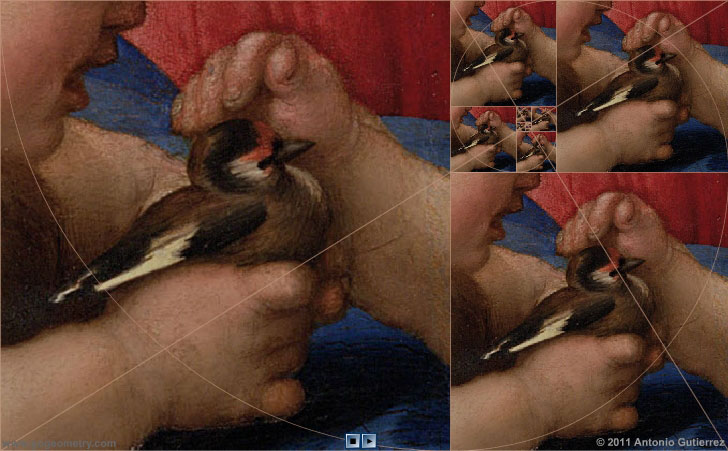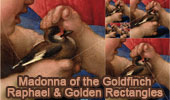 Madonna of the Goldfinch by Raphael and Golden Rectangles
Madonna of the Goldfinch by Raphael and Golden Rectangles
Successive Golden Rectangles dividing a Golden Rectangle into squares. St John holds a goldfinch.

The Madonna del Cardellino by Raphael is notable for its use of geometric principles in its
composition. Raphael employed the principles of
linear perspective to create a sense of depth and
spatial relationships between the figures and the
surrounding environment. He also used the Golden
Ratio, a mathematical proportion found in nature, to
create a harmonious balance of shapes and forms.
The Madonna and Child are positioned in the
center of the composition, with Saint John the
Baptist off to the side. The three figures are
arranged in a triangular composition, which helps to
create a sense of balance and stability. The use of
light and shadow, as well as the positioning of the
figures and the goldfinch, also contribute to the
overall sense of harmony and balance in the
painting.
Overall, the Madonna del Cardellino is a
masterful example of how geometry can be used to
create beauty and harmony in art. Raphael's careful
attention to proportion, composition, and
perspective helped to create a work of art that is
both aesthetically pleasing and emotionally moving.
Madonna del cardellino by Raphael
The Madonna del cardellino or Madonna of the Goldfinch is a painting by the Italian renaissance artist Raphael, from c. 1505-1506. A 10-year restoration process was completed in 2008, after which the painting was returned to its home at the Uffizi in Florence.
Read more.
Uffizi Gallery
The Uffizi Gallery is a museum in Florence, Italy. It is one of the oldest and most famous art museums of the Western world. Building of the palace was begun by Giorgio Vasari in 1560 for Cosimo I de' Medici as the offices for the Florentine magistrates. Source: Wikipedia, Uffizi.
Goldfinch
The European Goldfinch or Goldfinch (Carduelis carduelis) is a small passerine bird in the finch family.
In Madonna of the Goldfinch,
John the Baptist offers the goldfinch to Christ in warning of his future.
Golden rectangle
A golden rectangle
is a rectangle whose side lengths are in the golden ratio,
one-to-phi, that is, approximately 1:1.618. A distinctive
feature of this shape is that when a square section is
removed, the remainder is another golden rectangle, that is,
with the same proportions as the first. Square removal can
be repeated infinitely, which leads to an approximation of
the golden or Fibonacci spiral.
Droste Effect
The Droste effect is a specific kind of recursive picture, one that in heraldry is termed mise en abyme. An image exhibiting the Droste effect depicts a smaller version of itself in a place where a similar picture would realistically be expected to appear. This smaller version then depicts an even smaller version of itself in the same place, and so on. Only in theory could this go on forever; practically, it continues only as long as the resolution of the picture allows, which is relatively short, since each iteration geometrically reduces the picture's size. It is a visual example of a strange loop, a self-referential system of instancing which is the cornerstone of fractal geometry.
Source:
Wikipedia,
Droste Effect.

|